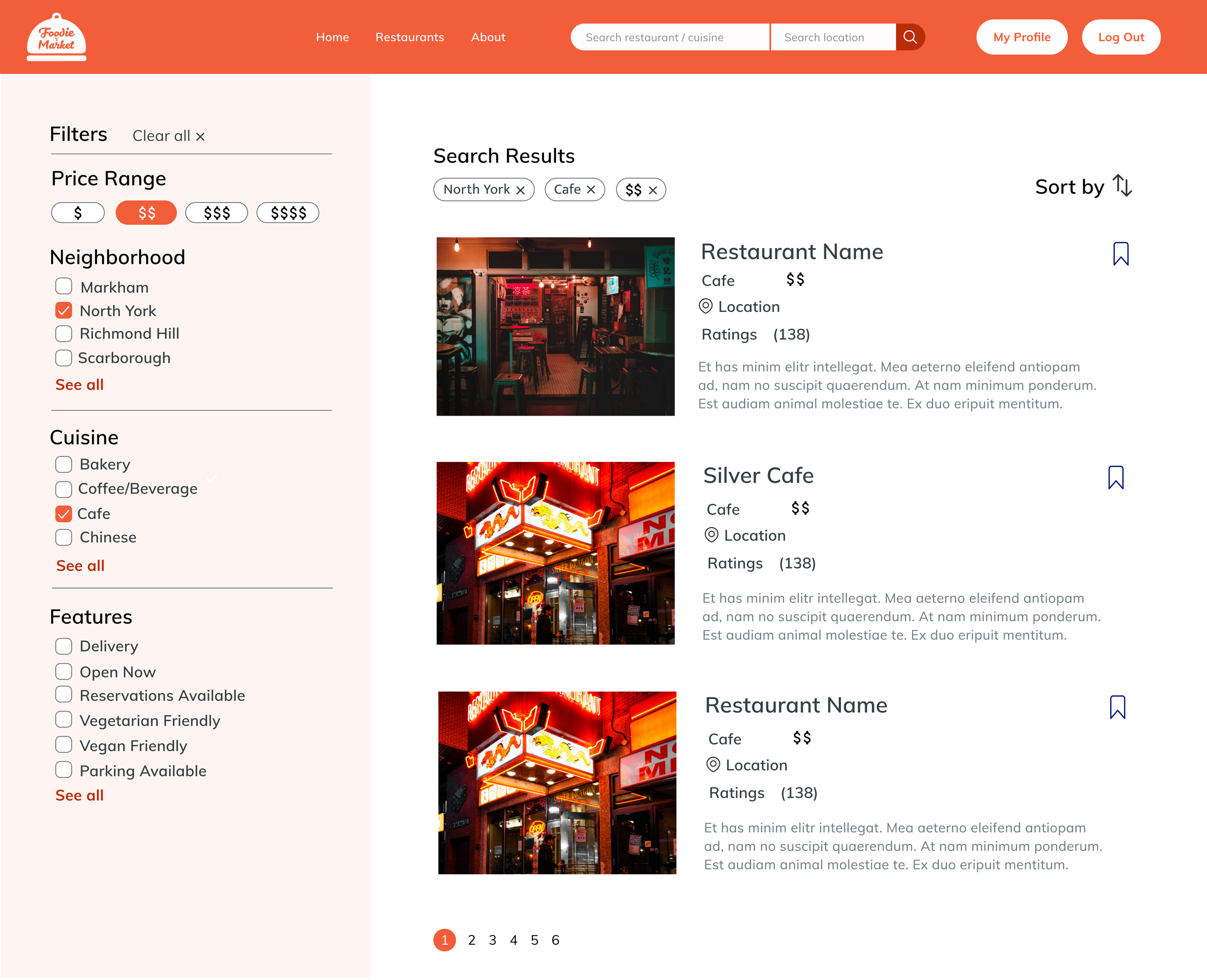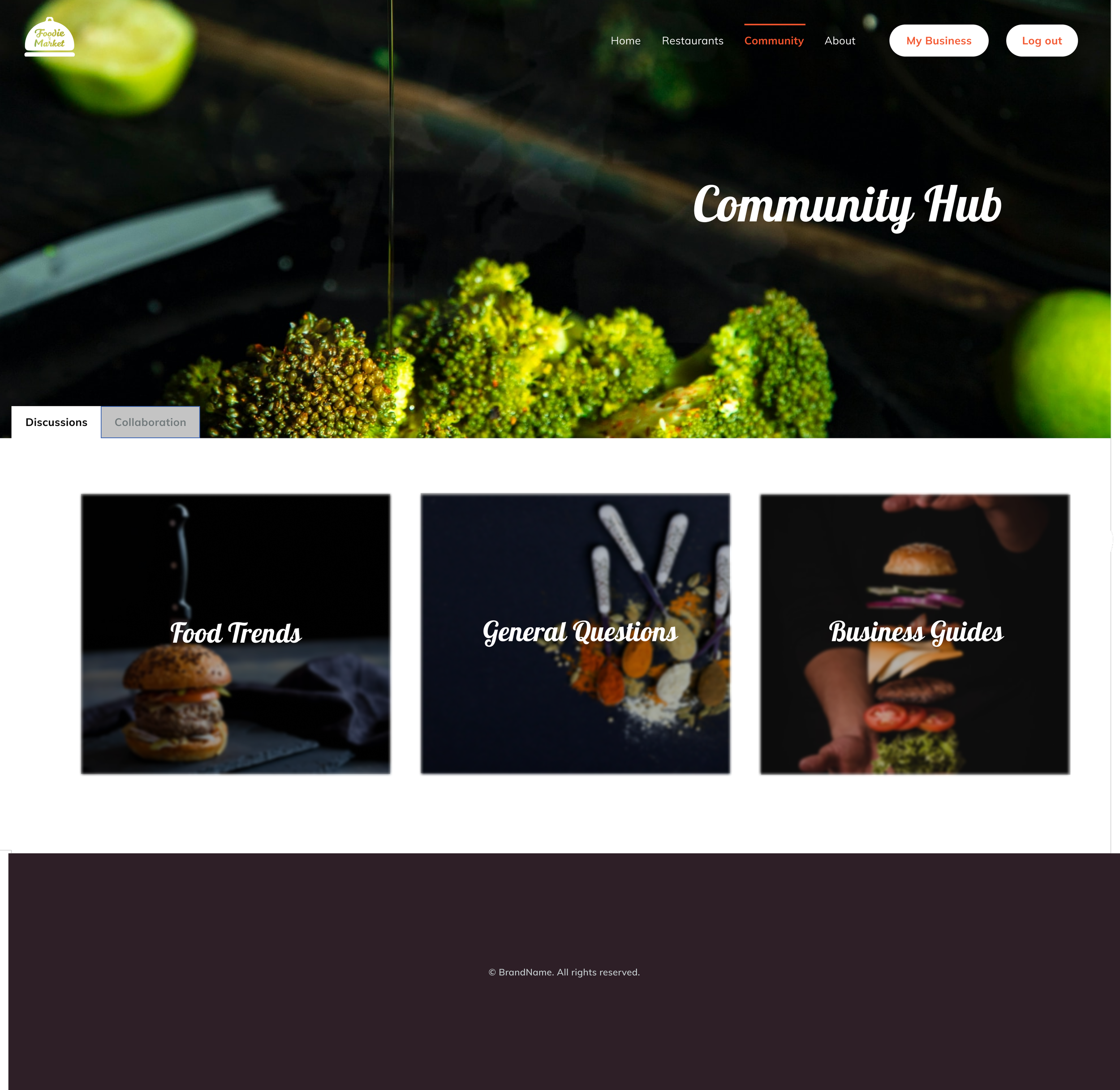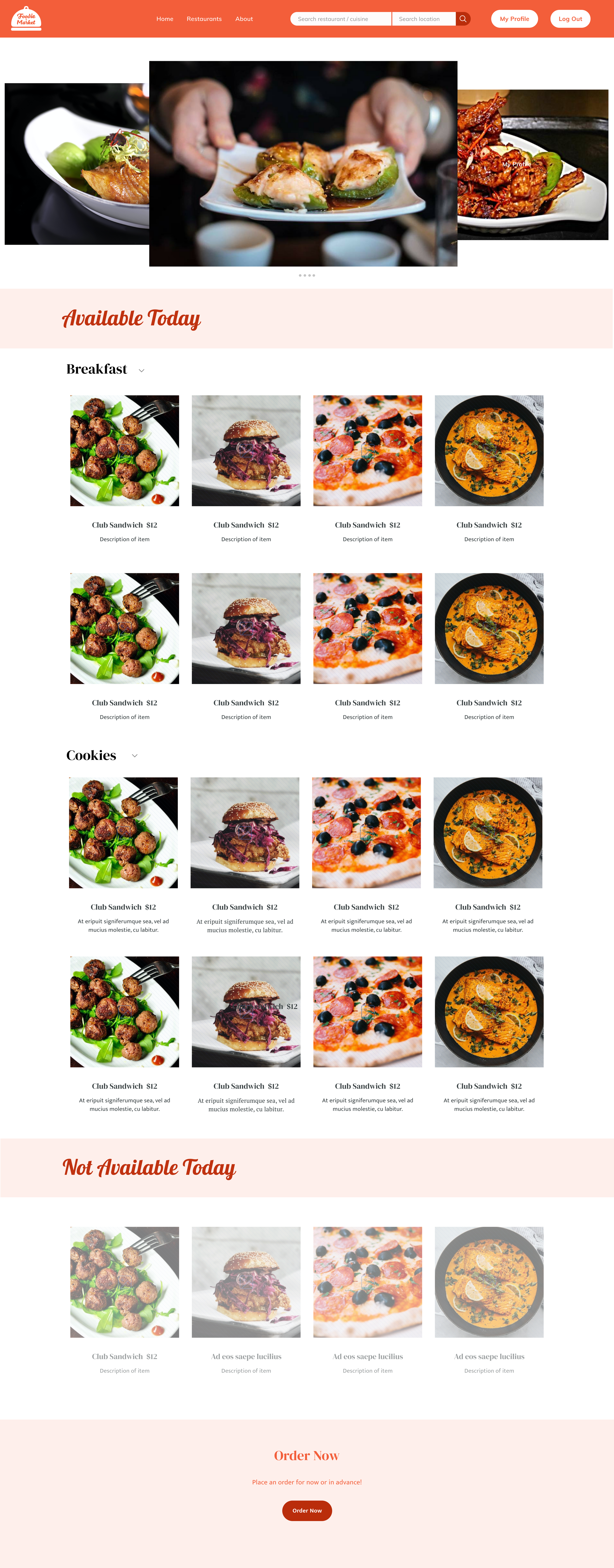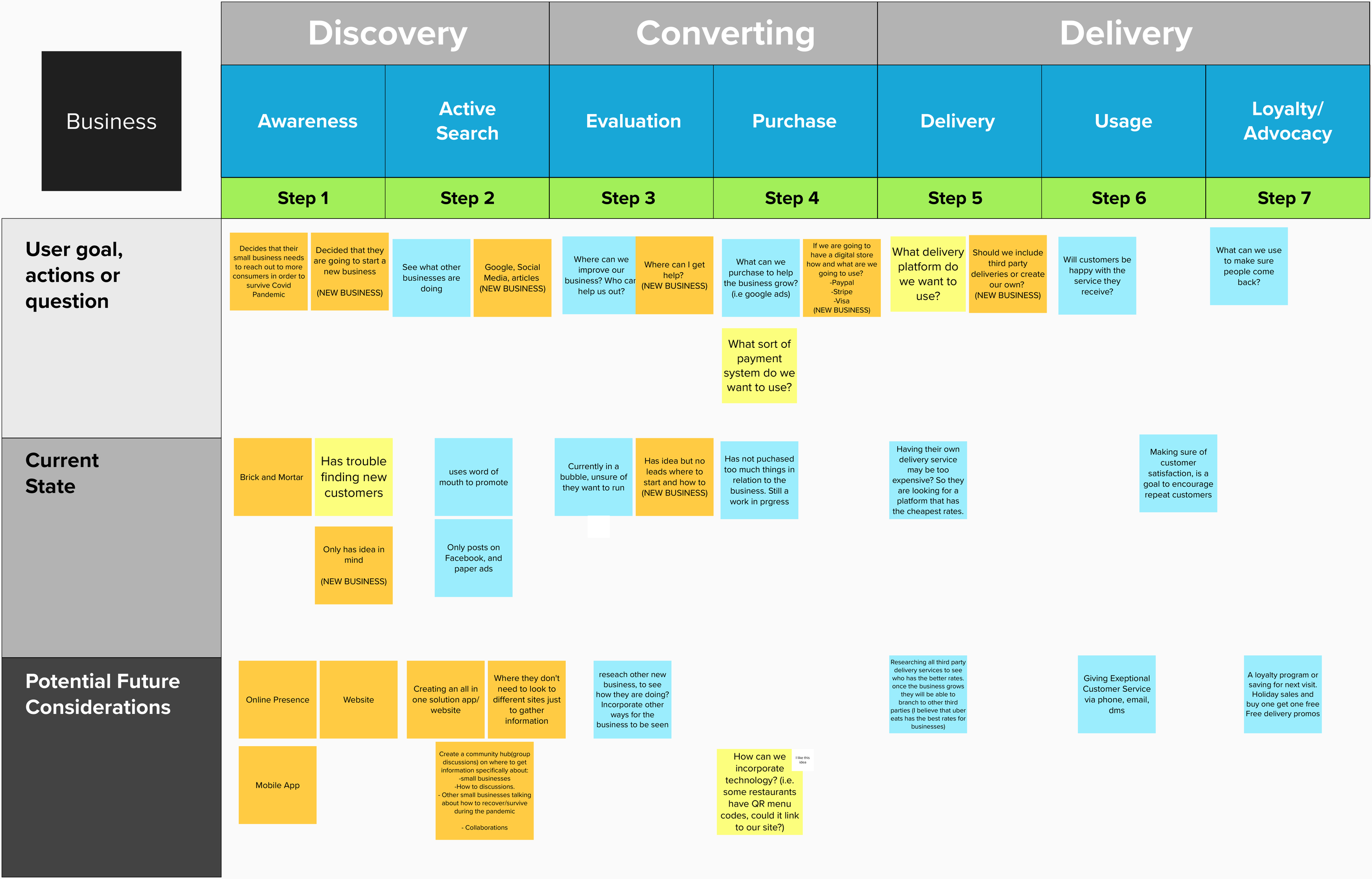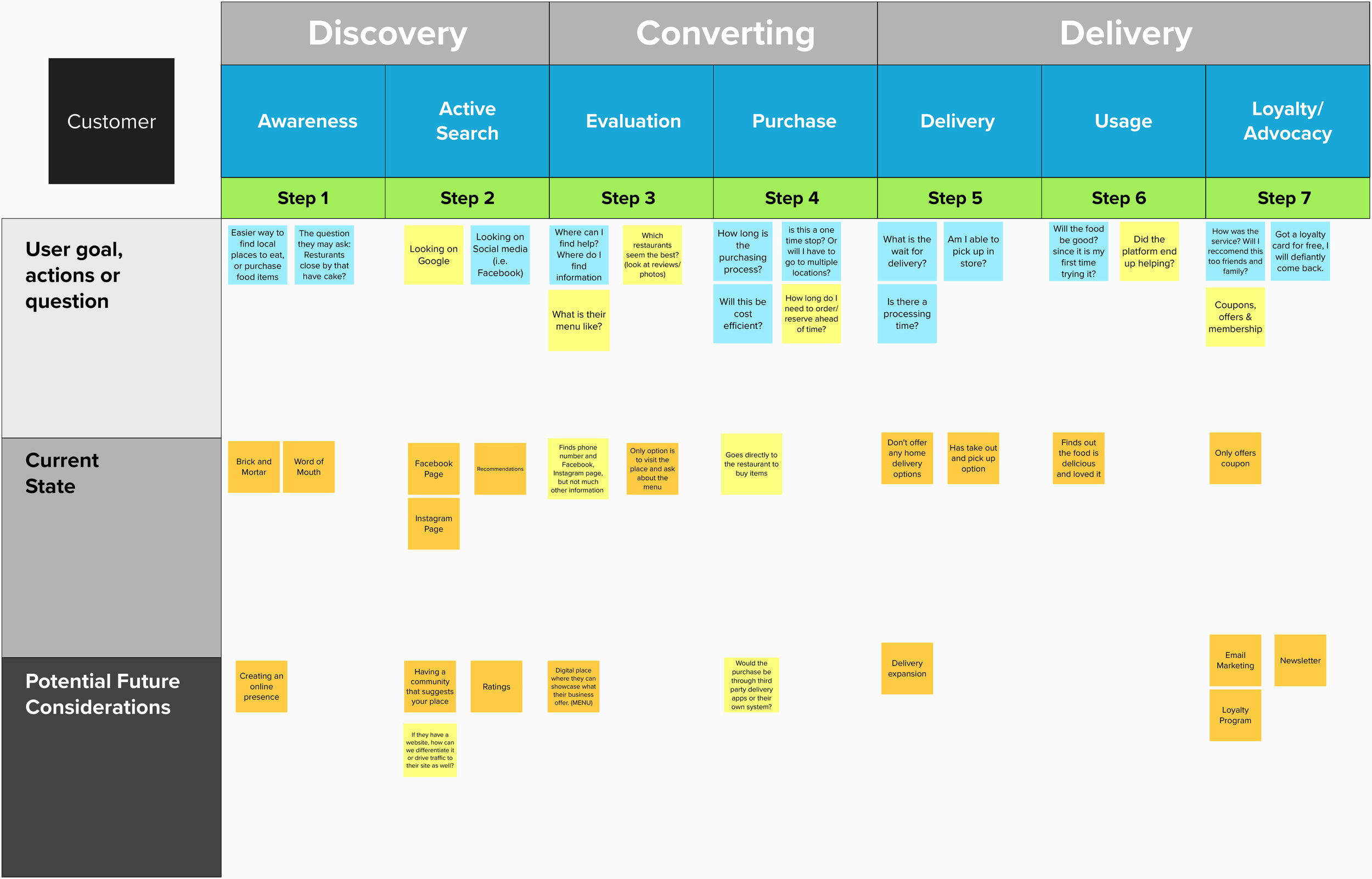Foodie Market
Project for Prepr F.U.N Program
Winter 2021
This was a collaborative project with a multidisciplinary team for the Prepr F.U.N Program. The objective was to create a solution to help businesses navigate through the pandemic and our team decided to create an all in one solution website for small businesses struggling to adapt to the digital landscape. The main aim was to offer community outreach services and help them develop a more effective online presence to make better use of technology and gain more exposure. The other goal was to create a better user experience for customers and make it easier for them to be able to find restaurants and the food they want. My role included project management, conducting market and user research, designing the brand identity and graphic assets, creating wireframes and prototypes, as well as creating a marketing strategy. On the left is a selection of pages from the full prototype available below.
The Problem/Opportunity
The problem we identified was that many small businesses within the food industry lack an effective online presence. The lack of user-friendly options make it difficult for difficult for customers to order items even if they want to, so businesses will take a huge hit during pandemic and lockdown times when customers aren’t allowed in stores or there are capacity restrictions, as there is a lack of foot traffic and delivery options. In fact, owners of food services and drinking places were much more likely to report lower revenue in 2020 than businesses overall (86.5% versus 60.5%). Many restaurants have adapted to the pandemic by shifting to contactless delivery and take-out service, with almost one-fifth (19.4%) making 30% or more of their sales online in 2020, more than double the rate in 2019 (9.1%). Also more and more customers want to have the option to order online even in the future and half (50.7%) of these businesses said that they were likely or very likely to permanently adopt contactless delivery or pickup options going forward. The digital customer experience will be critical to retaining current customers and capturing new ones, hence digitization is something that will become even more important to the food industry moving forward.
User Research
The target users for this problem would include both customers and businesses. On the customer side, our target user belongs to the 18-34 demographic, as they are the largest demographic who uses services such as Yelp and Skip the Dishes. For example, a mid-20’s foodie who enjoys finding new places to try, but has trouble doing so, especially when they’re in unfamiliar neighborhoods. Looking at online reviews and the restaurants digital presence can help, however it’s very inconsistent, as not all restaurants have enough reviews or a good digital presence. The less information there is, the less likely they would buy from the restaurant. I interviewed a few people within the target demographic and discovered that they are frustrated at the difficulty of finding information about certain smaller restaurants (i.e. they only have an instagram presence or a badly designed website) and discovering new restaurants themselves, especially concerning the lack of menus. They found delivery and takeaway options to be quite varying as well, especially for places like dessert shops, bakeries and cafes and did not like having to call the restaurant to ask questions. They also want to be able to have the option to reserve tables as well to join a remote queue, for convenience and liked the idea of having discounts and coupons. Another suggestion was being able to bookmark restaurants and create collections for future reference, as well as filter restaurants for dietary needs.
On the business side, our target user would be small restaurants within Toronto, for example a bakery that my teammate interviewed as part of our business challenge. Bakeries and other places such as dessert shops in general have a more volatile menu that is subject to change and they also tend to take on customized or more in the future orders, so being able to digitize and present that as an option to customers who can’t or don’t want to make orders in person would be very valuable. Other pain points would include making sure customers are always interested, being able to keep return customers, the difficulty of marketing on Instagram and competing with other restaurants. Gaining more exposure in general was also quite challenge. They found that having Uber promos and having more good reviews was useful in keeping customers engaged. All in all, there is a lot they need to change to make sure that they maintain a customer base, especially because they were closed for so long due to the pandemic.
Customer Journey Mapping
Needs & Pain Points
Based on a few interviews we conducted with our target users, we identified their most important needs and pain points.
Consumers:
Standardize content and provide consistent information across all restaurants, so we can bridge the gap between the variability of menus between different restaurants and provide the information customers need to be able to make easier decisions
Improve on filtering options in search functions
A clear menu for all restaurants
Have the option to reserve tables and join a remote queue to cut down wait time
Have the ability to bookmark restaurants and create collections
Being able to filter restaurants for dietary needs
Better delivery and takeout options if it’s lacking
Discounts and coupons provide more incentive
Businesses:
Want to gain more exposure
Trouble marketing and digitizing
Keeping customers interested
Attracting new customers
Being able to change items on menus
Product Overview
Digital Presence & Use of Technology
2. Delivery Expansion
3. Community Outreach
The key benefits of our solution include networking/outreach functions for businesses, more delivery and curbside pickup options and our technology can help them with digitization, in regards to the ordering system, digital menu and table reservations. Our site will also allow them to promote their business more effectively and make it easier for customers to discover them. On the customer side, the key benefits are convenient functionality. For example, they are able to see the full menu of restaurants/bakeries, reserve tables, get and use coupons, join a remote queue to prevent long waiting times, write reviews and see ratings and bookmark restaurants for future consideration all on one site. They can also discover more restaurants and see what they have to offer much more easily. We’re really looking to leveraging the use of technology to both help businesses grow and better the customer experience.
Sitemap
Wireframes & Designs
Brand Elements
Prototype
User Testing
We interviewed a few users from the target demographics on both the customer and business side and explained the site, showed them different versions and walked them through the IA and user-flow before showing them the screens we had created.
Customer Insights:
They really liked the design and idea of the site and thought it would be really convenient and useful in finding out more information about small restaurants.
However, they found the homepage to be a little confusing and redundant, with the Featured Restaurant, What’s Hot and Weekly Chart.
Business Insights:
They loved the overall idea of the site, as “an online marketplace would be super useful to small businesses to help them get the customers they need to survive”
The layout is really pretty
Being able to have a singular site that would help me promote the business
Although it might be very competitive, not that it is not competitive on uber, skip or doordash.
Although these platforms have a way for small businesses to grow, by using discounts and promotions.
Being able to have a one stop shop is something that has not been seen before. you have promotions and discounts you also appear on the first page. However it does not help too much because it depends on people clicking in a way. It is not really a form of marketing or a place where we can explain our product. People usually already know us or have ordered from us before.
When watching users interact with the prototype it seemed very straight forward
It is very user friendly
They enjoyed the idea of the website it
The colours were very captivating
They would enjoy using this as a marketing tool


